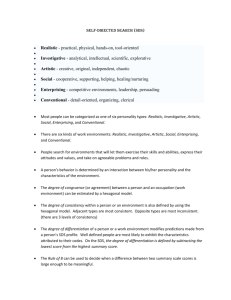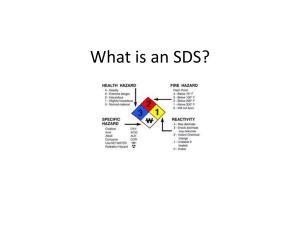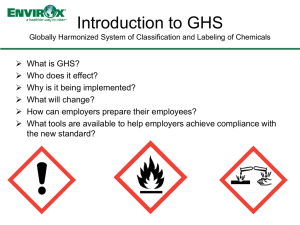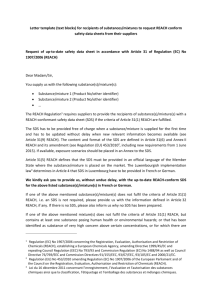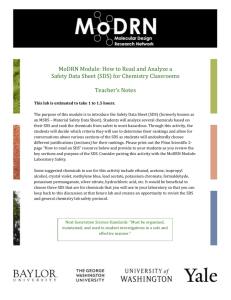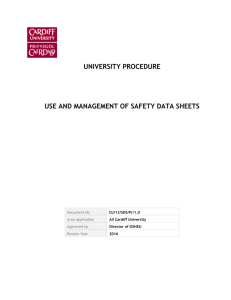Haz Comm SECONDARY LABELING
advertisement
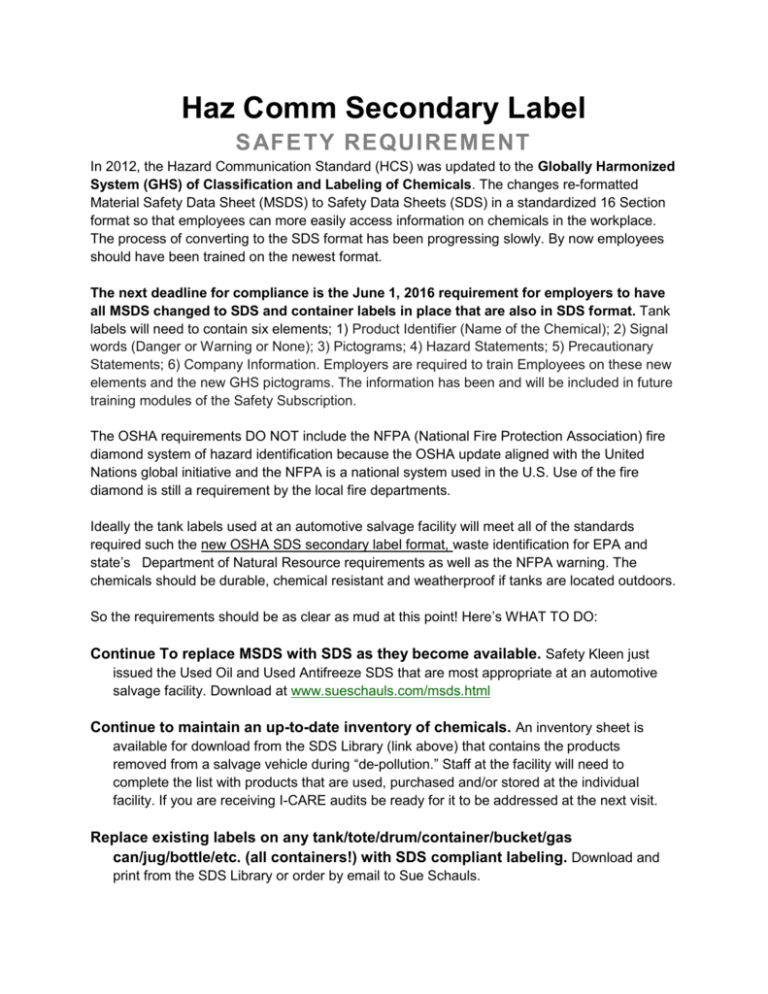
Haz Comm Secondary Label SAFETY REQUIREMENT In 2012, the Hazard Communication Standard (HCS) was updated to the Globally Harmonized System (GHS) of Classification and Labeling of Chemicals. The changes re-formatted Material Safety Data Sheet (MSDS) to Safety Data Sheets (SDS) in a standardized 16 Section format so that employees can more easily access information on chemicals in the workplace. The process of converting to the SDS format has been progressing slowly. By now employees should have been trained on the newest format. The next deadline for compliance is the June 1, 2016 requirement for employers to have all MSDS changed to SDS and container labels in place that are also in SDS format. Tank labels will need to contain six elements; 1) Product Identifier (Name of the Chemical); 2) Signal words (Danger or Warning or None); 3) Pictograms; 4) Hazard Statements; 5) Precautionary Statements; 6) Company Information. Employers are required to train Employees on these new elements and the new GHS pictograms. The information has been and will be included in future training modules of the Safety Subscription. The OSHA requirements DO NOT include the NFPA (National Fire Protection Association) fire diamond system of hazard identification because the OSHA update aligned with the United Nations global initiative and the NFPA is a national system used in the U.S. Use of the fire diamond is still a requirement by the local fire departments. Ideally the tank labels used at an automotive salvage facility will meet all of the standards required such the new OSHA SDS secondary label format, waste identification for EPA and state’s Department of Natural Resource requirements as well as the NFPA warning. The chemicals should be durable, chemical resistant and weatherproof if tanks are located outdoors. So the requirements should be as clear as mud at this point! Here’s WHAT TO DO: Continue To replace MSDS with SDS as they become available. Safety Kleen just issued the Used Oil and Used Antifreeze SDS that are most appropriate at an automotive salvage facility. Download at www.sueschauls.com/msds.html Continue to maintain an up-to-date inventory of chemicals. An inventory sheet is available for download from the SDS Library (link above) that contains the products removed from a salvage vehicle during “de-pollution.” Staff at the facility will need to complete the list with products that are used, purchased and/or stored at the individual facility. If you are receiving I-CARE audits be ready for it to be addressed at the next visit. Replace existing labels on any tank/tote/drum/container/bucket/gas can/jug/bottle/etc. (all containers!) with SDS compliant labeling. Download and print from the SDS Library or order by email to Sue Schauls. Recently AVERY came out with a label product that meets that exact needs for durable chemical and weather-resistant labeling for those with a laser printer. The Avery labels are available directly from Avery or from discount office supply stores. Look for Avery Ultra Duty GHS Chemical Labels. To print the labels in the SDS Library order the half page labels, two per sheet, Avery Label 60502. Other SDS compliant labels will continue to be made available for order or download as the SDS become available. Don’t panic if you do not have the SDS for a product even though the manufacturers and suppliers deadline is December 1, 2015, OSHA has realized the conversion is taking more time than anticipated. Use the extra time to get your program started or updated so that next June you are not overwhelmed with the task. Hazard Communication Program SAFETY REQUIREMENT Hazard Communication Standard (HCS) is the rule that requires employers to provide training and chemical hazard information to their employees. The requirement of maintaining an inventory and the safety data sheets (SDS) for chemical found in the workplace is the most commonly know portion of the rule. Having a Safety Supervisor, SDSs, monthly training and a written Safety Plan or Hazard Communication Program meets the requirements of the rule. Under the provisions of the Hazard Communication Standard, employers are responsible for informing employees of the hazards and the identities of workplace chemicals to which they are exposed. Recently the United States agreed to the Globally Harmonized System (GHS) of Classification and Labeling of Chemicals. This simply means that the Safety Data Sheet (SDS) for chemicals will be formatted in the agreed United Nation’s standard look in the native language of nations across the globe. The Hazardous Communication Program has three important components with records of each retained in the SAFETY binder: 1) An Inventory list of hazardous chemicals at this salvage yard. The inventory list of chemicals at the facility is kept in the front of the SDS binder. Employees are asked to help identify products used in the shop that may need an SDS. Everyone must work together to keep each other safe. 2) Safety Data Sheet (SDS) and labels for each hazardous chemical. An MSDS or SDS is an informational sheet used to communicate hazardous characteristics of chemicals found in the workplace. The MSDS/SDS and container labeling are vital resource for handling those chemicals in an emergency situation. Labels are not removed from any container or defaced in any manner. New SDS compliant labels will be used on products as the GHS format Safety Data Sheet become available. 3) A written hazard communication program. Employees will be trained on hazardous chemicals in their work area at the time of their initial assignment and whenever a new hazard is introduced into their work area. This will ensure that employees have the necessary information prior to exposure to prevent the occurrence of adverse health effects. Retraining will be done when a new hazard is introduced into the work area, not a new product. Visit the SDS LIBRARY at www.sueschauls.com/msds.html to find the SDS for Used Oil, Used Antifreeze, Gas and Diesel and many other automotive salvage workplace chemicals.


